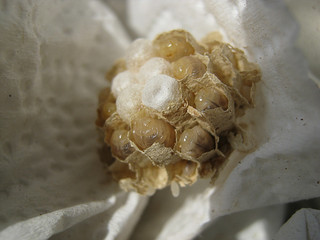Will Baby Wasps Still Emerge From That Nest?
By Chris Williams on November 28, 2014.
A few weeks ago, I drove a seldom-used vehicle into town. On the way, droves of red wasps came out from around the windshield wipers. After about 20 miles, no more wasps came out. Since then, I’ve driven the car, taken it in for a wash and wax, and then an oil change with no more wasps. The nest must be hidden because the oil changer never even saw it. Are the baby wasps that might be in the nest going to hatch? Jana
 Jana, that sure sounds like an exciting experience! Clearly wasps had built a nest somewhere under the hood of your car and all the disturbance and rushing air drove them out. Most of the wasps were probably not on the nest at the time anyway, but were out foraging when you took the car for a spin. It’s common for wasps to build nests in old abandoned (or little-used) vehicles, boats, or unused outdoor equipment like lawn mowers, barbecue grills, or playground equipment. To the wasps, a junk car is just another immovable object with lots of good cubby holes to nest in.
Jana, that sure sounds like an exciting experience! Clearly wasps had built a nest somewhere under the hood of your car and all the disturbance and rushing air drove them out. Most of the wasps were probably not on the nest at the time anyway, but were out foraging when you took the car for a spin. It’s common for wasps to build nests in old abandoned (or little-used) vehicles, boats, or unused outdoor equipment like lawn mowers, barbecue grills, or playground equipment. To the wasps, a junk car is just another immovable object with lots of good cubby holes to nest in.
There almost certainly were wasp larvae (“baby wasps”) in the nest that would eventually turn into adult wasps if given the opportunity. The amount of larvae developing depends on the time of the season. Early in summer, when the nest is being constructed and eggs are being laid by the queen, there are fewer worker wasps and fewer developing larvae. By mid to late summer, worker wasps are plentiful and they are busy bringing insect food to the larvae that are eating and growing inside the nest.
Wasps That Have Already Pupated Can Survive
When the worm-like larvae are fully developed, they pupate right inside their nest cells, and several days later, an adult wasp emerges. When insects pupate, they are fully grown and no longer need to feed. During the pupal stage, they don’t move much either but internal changes are going on that turn them into the adult form of the insect.
The answer to your question is that any wasp larvae already in the pupal stage could continue to hatch out as wasps. Likewise, any fully-grown larvae that were about to pupate could probably complete that process. But any smaller larvae that were still developing would die since there would be no adult wasps left to feed them.
This Year’s Wasps Are Long Gone
There’s also the possibility that all of the disturbance of the car running, the soapy car wash, and the oil change would have killed anything still alive in the nest. The nest could have been blown completely out of the car, too, which would explain why it wasn’t seen. And by this time of year, we have had a hard frost which also would kill anything still alive in the nest.
It’s always important to eliminate a wasp’s nest that is in a problem location (I think a car’s engine qualifies) as early in the season as possible while the nest is still small and there are few workers. Just be glad that these wasps removed themselves, rather than having someone open the hood to be greeted by a horde of angry wasps!
Photo credit: jeferonix / Foter / CC BY-SA
Sign up for our biweekly email newsletter for more information about bugs and pests!